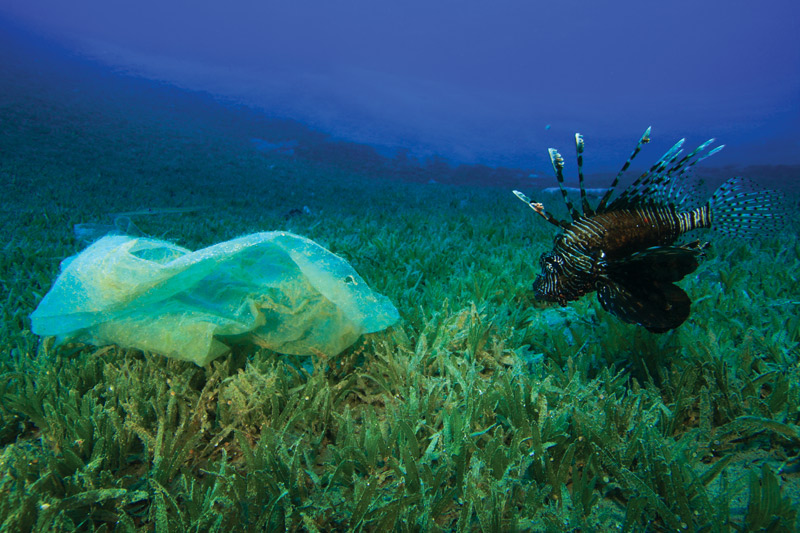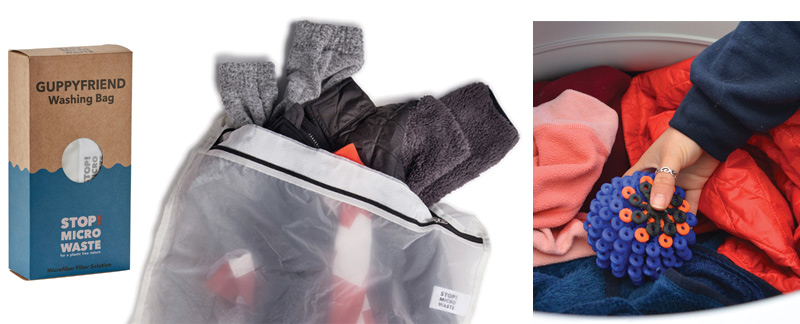
 Turns out, the solution to microplastics pollution may come down to everyday folks like us, and boaters can lead the charge.
Turns out, the solution to microplastics pollution may come down to everyday folks like us, and boaters can lead the charge.
What are microplastics, anyway? Microplastics are small plastic pieces less than 5mm (0.2”) long that are harmful to our oceans and waterways. We have known for some time that plastics are the main type of marine debris in the oceans and Great Lakes of North America. Some very preliminary research is showing similar problems in other ocean and lake systems around the world.
Plastics are so widely used because they are tough, don’t deteriorate easily, and are quickly, easily, and cheaply made. The things that make plastics so dangerous in the environment is that they are tough, don’t deteriorate easily, and are quickly, easily, and cheaply made.
Plastics end up in the ocean in many ways and in many forms. Some are simply thrown in by boaters or those who frequent beaches and shorelines as visible litter. Some wash into oceans and lakes with flooding or tsunamis. Larger pieces are obvious, and as more people, boaters and non-boaters alike, become aware of this type of pollution, thousands of shoreline residents across North America spend a day or two a year on organized waterways and beach cleanups.
As the larger pieces break down due to wave action and scrubbing along beaches and river banks, they become small enough to enter the microplastic classification. These pieces are small enough to be eaten by fish that mistake them for food, and that’s how many microplastics get into the food chain.
Other newly understood sources of microplastics entering the waterways come from everyday items used by millions of people daily in the Western world – makeups, facial scrubs, and even toothpaste. Plastic microbeads are used in the manufacturing of these products. They have been used in personal care products for more than 50 years. Until about five years ago, most consumers were unaware that the use of microplastics was so widespread.
On December 28, 2015, former U.S. President Barack Obama signed the Microbead-Free Waters Act of 2015, which prohibited the use of plastic microbeads in cosmetics and personal care products. Time will tell how the current Administration and Congress handle the issue.
The British Parliament passed legislation prohibiting plastic microbeads in personal care products by the end of 2017, and pressure to do the same is being applied to other governments around the world. The war against microbeads used in manufactured products has been fully engaged, and it appears that progress is being made in that battle.
However, another, potentially more insidious, plastic by-product is making its way into waterways around the world, and it’s the result of washing certain types of modern clothing. Many of the clothing items worn, from yoga pants to waterproof jackets and fleeces, are made of polyester threads. Almost all fleeces and other wicking and breathable products are woven of the same type of thread. Chemically, the material is polyene terephthalate, also known as PET.
Many of these threads are made of used plastic bottles or worn-out clothing, which are crushed, shredded, melted, and extruded to make the polyester thread used in many fleece, athletic performance, and other products. What the world is now dealing with are the small bits of PET thread that break off a garment every time it’s washed. They are not the chemical pollutants or the byproduct of industrial production. They are what has been termed “structural pollutants.”

Right: The Pacific Northwest’s shellfish farms are particularly vulnerable to
microfiber pollution (and pollution in general)
This revelation has led to headlines in the popular press along the lines of, “Your yoga pants (or fleece jackets, breathable clothing, microfiber wiping cloths, etc.) are poisoning our oceans.” The other headline that appears regularly is something like, “If you’re eating seafood, you’re eating plastic.” In the first headline, if we substitute the word “polluting” for “poisoning”, we would be able to say both popular press headlines would be accurate.
Researchers around the world have decided to call these bits of polyester thread microfibers. While garments made of this type of fabric are widely worn now, polyester fabrics first burst onto the scene nearly half a century ago. They were the basic material used in “disco” or “leisure” suits, and were considered the height of fashion in the late 1960s and into the 1970s. Now most workout gear, waterproof jacket shells, and fleeces are made of the same basic material. We are seeing a major move among makers of soft furniture – couches and padded chairs — to use stain-proof fabric made of microfibers.
All these products shed plastic thread particles when they are washed. Exercise clothing, because of the nature of its use, is washed almost every time it’s worn. A University of California study has found that 1.7 grams (0.06 oz.) of microfibers are shed every time a synthetic fleece jacket is washed. These particles make their way into the waterways, where they are ingested by fish and other organisms.
Research done by the State University of New York examined fish caught in the Great Lakes and found microfibers had woven themselves into their gastro-intestinal tracts. These same microfibers are the second most common type of pollution in Lake Michigan.
An Australian study has concluded that microfibers make up 85 percent of human-produced debris along shorelines around the world. Other research – focusing on both salt and freshwater shorelines – supports the finding of the Australian study.
British Columbia research revealed that 25,000 plastic particles and microfibers were contained in one cubic meter of water collected along the B.C. Coast. Washing a single sweater can release up to 10,000 bits of microfiber, according to the research.
The Nanaimo campus of Vancouver Island University has been examining B.C. shellfish, and Dr. Sarah Dudas is leading this team that has harvested thousands of oysters from various locations along the B.C. Coast. She reports finding microfibers in almost every oyster. Dr. Dudas says research has yet to determine how microfibers might affect food safety or food security. She reports excellent cooperation from oyster farmers along the B.C. Coast.
“The industry put some money into our study,” she says, “and we leveraged that to obtain additional funds from the government, and shell fish farmers along the coast want to be kept up to date on
our research.”
Research is being done locally at sewage treatment plants to measure the amount and type of microfibers coming into the sewage plants and to check again after treatment to see what is discharged. We understand the Vancouver Aquarium has done some effective research into this topic, but aquarium policy forbids their staff from discussing their work with the media without prior approval from the public relations department.
Patagonia Outdoor Clothing and Gear, one of the largest manufacturers of clothing made of synthetic material, has embarked on a program to educate buyers to combat microfibers. The company plans to provide customers with information on the care of any synthetic product, not just its own. Patagonia will advise customers that research shows synthetic jackets washed in top-loading washing machines shed five times more microfibers than those washed in a front loader.
It will also make available, at its cost, a Guppy Friend bag into which a user can put synthetic clothing for washing. The bag and clothing is washed normally, but the tight weave of the bag material stops much of the microfibers from going into the washer’s drain. The microfibers can then be taken from the bag and disposed of as ordinary garbage. These bags are now available for $20 at all Patagonia outlets in Europe and North America.

Right: The Cora Ball is a microfiber pollution management tool under development. Just throw it in with the laundry! Check out the kickstarter campaign for more details (kickstarter.com)
Patagonia also recommends the installation of a permanent washing machine filter, Wexco’s Filtrol 160, to help reduce the microfibers going down the drain. This filter was developed years ago to keep lint out of septic fields. The company also notes a device currently under development called Cora Ball that, when thrown into a washer along with the clothes, gathers up microfibers, which can be removed and disposed of in normal garbage.
A number of washing machine manufacturers are working on built-in filter systems that will trap microfibers for easy removal like most dryers trap lint. Researchers are also examining the possibility that additional filtering at sewage treatment plants might be helpful in reducing microfibers in the waterways.
Patagonia and other fleece manufacturers are reminding users that it is not necessary to wash any good quality fleece item after a single wearing. For example, they note that if the outer shell of a breathable-fleece lined jacket gets muddy, it can be wiped clean with a damp cloth or sponge. Other manufacturers also remind users that many items can be hand rinsed in freshwater and hung to dry naturally.
It is clear that various manufacturers of fleece clothing are taking the microfiber issue very seriously. Even retailers who do not manufacture products, such as Vancouver B.C. Mountain Equipment Co-Op, make cash contributions to ongoing research projects.
In fact, a major, two-year research project examining microfibers in the waters from Texas to the Florida Keys is currently underway. This particular research uses both professionals and volunteers as part of the project and, therefore, hopes to recover more data than if it was done by paid personnel only.
Individual boaters can help reduce microfiber pollution by using 100% cotton cleaning cloths on board, rather than microfiber cleaning cloths. They can also dress against the cold by wearing cotton or wool garments rather than fleece clothing. When replacing washing machines, either on their boats or at home, they can opt for front loaders. Staying tuned with the developments in washing machine filters and products like the Cora Ball and Guppy Friend bag is also key, and such measures may need to become regular household practice.
In general, most researchers agree that an informed public can, and will, be the first line of defense against further microfiber pollution. There is no doubt that fleece fabrics are excellent clothing items that the public now accepts and will continue to demand.
There is also no doubt that fleece manufacturers and retailers have stepped up to the plate to find a way to counterattack the environmental impact of their products.
Under such circumstances, many in the marine industry are satisfied that it won’t be long before a solution to the microfiber problem surfaces. Until then, boaters should stay vigilant on the issue. We are facing a big mess, but we can all do our part to restore our plastic-free oceans.